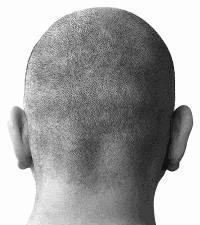My Hair Hurts! Migraine and Allodynia
Like about 2/3 of migraineurs, allodynia is one of the wonderful symptoms that comes along with many of my migraine attacks. It’s always uncomfortable, and usually painful, and believe it or not most people have never heard of it.
Allodynia. Migraineurs often suffer from cutaneous allodynia – that is, sensitivity and/or pain when the skin is touched. Most common in women, it often comes during the headache stage of a migraine attack (if there is a headache at all), but for many people it comes before, and is a kind of "warning signal". The skin becomes so sensitive, that it may feel like your "hair hurts". Running a comb through your hair can be excruciating.
 |
Though allodynia on the scalp is the most commonly known, some people (like me) get sensitivity on other parts of the skin – such as the arms. If you wear jewelry, it might become impossible during an attack. Just wearing a shirt can cause a great deal of pain – that’s right, just the brushing of a sleeve against your skin. Standing near a stove, even standing in the wind, can be a real problem.
Muscle tenderness could also be a related symptom, especially in the head and neck.
Studies are showing us how allodynia fits into a migraine attack. It’s believed that the hypersensitivity is a part of the migraine chain reaction, where neurons become sensitized. A vicious cycle of hypersensitivity and pain is a main feature of the migraine reaction in the brain.
Though for some the symptom is brief and not worth comparing to other symptoms (like headache or nausea), for others it can be very debilitating. It also may be that people with allodynia are at risk for worsening migraine – where you start having attacks more and more often. So what about treatment?
Treating Migraine with Allodynia
We’re still waiting for research on many of the new medications that are being used for migraine. It’s been suggested that one of the older (and now less frequently used) medications, may help with allodynia in some patients. That is dihydroergotamine (DHE).
Another class of drugs that might help is a cyclooxygenase inhibitor, a type of anti-inflammatory drug. There have been concerns about Cox2 inhibitors and their link to heart problems. However, if your symptoms are severe you may want to give one a try after talking to your doctor.
Some studies have suggested that triptan drugs (like Imitrex) don’t work well in the presence of allodynia. Today, this is being questioned.
Probably your best bet is to treat migraine as a whole, and if you’re taking abortive medication take it as soon as you feel the migraine attack starting. Generally speaking, if you find a treatment that fights your migraine attacks, you should also find your allodynia decreasing.
There is one thing that can make allodynia worse – and that is opioid drugs, such as codeine and meperidine (Demerol). In most cases these are better avoided in migraine treatment, but allodynia may give you another reason to look for other options.
Allodynia and Migraine – Summary
Pain on your skin, especially the scalp and arms, is very common in migraine. It’s not your imagination! It’s actually an important feature of migraine that is teaching us more about what happens in the brain during an attack.
As you treat your migraine disease, pay attention to increasing or decreasing allodynia, and discuss it with your doctor. You may be able to find better treatment options, using allodynia as another clue.
